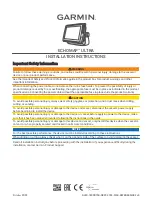
Tools Needed
• Drill
• Drill bits
◦
Bail mount: drill bits and screws appropriate for the surface and hardware
◦
Flush mount: 3.2 mm (
1
/
8
in.) and 9.5 mm (
3
/
8
in.) drill bits
• #2 Phillips screwdriver
• Jigsaw or rotary tool
• File and sandpaper
• Marine sealant (optional)
Mounting Considerations
You can flush mount the device in the dashboard or bail mount the device on the dashboard.
When selecting a mounting location, observe these considerations.
• The mounting location must provide a clear view of the screen and access to the keys on the device.
• The mounting location must be sturdy enough to support the device and the mount.
• The cables must be long enough to connect the components to each other and to power.
• To avoid interference with a magnetic compass, do not install the device closer to a compass than the
compass-safe distance value listed in the product specifications.
Bail Mounting the Device
NOTICE
If you are mounting the bracket on fiberglass with screws, it is recommended to use a countersink bit to drill a
clearance counterbore through only the top gel-coat layer. This will help to avoid cracking in the gel-coat layer
when the screws are tightened.
1 Select the mounting hardware appropriate for your mounting surface and for the bail-mount bracket.
2 Using the bail-mount bracket as a template, mark the pilot holes .
3 Using a drill bit appropriate for the mounting hardware, drill the four pilot holes.
4 Using the selected mounting hardware, secure the bail-mount bracket to the mounting surface.
5 Place the cradle into the bail-mount bracket, and tighten the bail-mount knobs .
6 Connect all necessary cables to the cradle (
), and spin the locking rings clockwise
to lock the cables to the cradle.
NOTICE
To prevent corrosion of the metal contacts, cover unused connectors with the attached weather caps.
2












